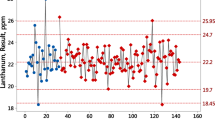Abstract
Sometimes analytical laboratories receive requests with a small number of determinations and/or a small number of samples, or outside the typical scope of analytical services. As a result, they may not have historical data on the performance of analytical processes and/or appropriate reference materials. Under these conditions it is difficult or uneconomical to use traditional or classic quality control charts. This is the so-called start-up problem of these charts. The Q charts seem appropriate charts under these conditions because they do not need any prior training or study phase. The fundamentals and the algebraic expressions of Q charts for the mean (four cases) and for the variance (two cases) are offered. This experimental study of Q charts for individual measurements was done with data from quality control for the evaluation of mass fraction of Ni and Al2O3 in a laterite CRM by ICP-OES. The performance of these Q charts is discussed where the analytical process is in the state of statistical control and in the presence of outliers at the start-up. In the first situation performance of Q charts are quite satisfactory and they behave properly. When outliers are collected at the beginning, the deformation of some charts is evident or the charts become useless. Severe outliers will corrupt the parameter estimates and the subsequent plotted points, or the charts will become insensitive and useless. The practitioner should take extreme care to assure that the initial values are obtained in the state of statistical control to have adequate sensitivity to detect parameter shifts.













Similar content being viewed by others
References
ISO/IEC 17025 (2017) General requirements for the competence of testing and calibration laboratories. International Standard Organization, Geneva
Thompson M, Wood R (1995) Harmonized guidelines for internal quality control in analytical chemistry laboratories. Pure Appl Chem 67:649–666
ISO 7870–2 (2013) Control charts – part 2: Shewhart control charts. International Standard Organization, Geneva
Westgard JO, Barry PL, Hunt MR (1981) A multirule Shewhart chart for quality control in clinical chemistry. Clin Chem 27:493–495
Quesenberry C (1991) SPC Q charts for start-up processes and short or long runs. J Qual Tech 23:213–224
Quesenberry CP (1993) On properties of Q charts for variables, institute of statistics Mimeo series number 2252, North Caroline State University. Available from www.nscu.edu.cu, accessed March 2015
Quesenberry CP (1995) On properties of Q charts for variables. J Qual Tech 27:184–203
Howarth RJ (1995) Quality control charting for the analytical laboratory Part 1 univariate methods. Analyst 120:1851–1873
Thompson M, Magnusson B (2013) Methodology in internal quality control of chemical analysis. Accred Qual Assur 18:271–278
Marques PA, Cardeira CB, Paranhos P, Ribeiro S, Gouveia H (2015) Selection of the most suitable statistical process control approach for short production runs: a decision model. Int J Inf and Ed Tech 5:303–310
del Castillo E, Montgomery DC (1996) Short-run statistical process control: Q-chart enhancements and alternative methods. Qual Reliab Eng Int 10:87–97
Quesenberry CP (1996) Response to short-run statistical process control: Q-chart enhancements and alternative methods. Qual Reliab Eng Int 12:159–161
Nelson LS (1984) The Shewhart control chart – Tests for special causes. J Qual Tech 16(237):239
Laboratorio central de minerales José Isaac del Corral (1986) CAMECON project l1, certificado de análisis de material de referencia certificado de laterita Niquelífera l1 and supplement 1
Empresa central de laboratorios José Isaac del Corral (2015) Standard operating procedure LRM-PT- 01
ISO 5725–3 (2023) Accuracy (trueness and precision) of measurement methods and results – Part 3: Intermediate measures of the precision of a standard measurement method. International Standard Organization, Geneva
JCGM 200 (2012) International vocabulary of metrology – Basic and general concepts and associated terms (VIM) 3rd ed. 2008 version with minor corrections
Statgraphics Corporation (2007) Statgraphics Centurion XV, version 15.2.05
Montgomery DC (1997) Introduction to statistical quality control. Wiley, New York
Mullins E (1994) Introduction to control charts in the analytical laboratory. Analyst 119:369–375
Hunter JS (1986) The exponentially weighted moving average. J Qual Tech 18:203–210
Crowder SV (1989) Design of exponentially weighted moving average schemes. J Qual Tech 21:155–162
Author information
Authors and Affiliations
Contributions
Both authors contributed to the study, conception and design of this article. Material preparation, data collection and analysis were performed by Manuel Alvarez-Prieto and Ricardo Páez-Montero. The first draft of the manuscript was written by Manuel Alvarez-Prieto and the coauthor commented on previous versions of the manuscript and the final one. Both authors read and approved the final manuscript.
Corresponding author
Ethics declarations
Conflict of interest
The authors declare no competing interests.
Additional information
Publisher's Note
Springer Nature remains neutral with regard to jurisdictional claims in published maps and institutional affiliations.
Supplementary Information
Below is the link to the electronic supplementary material.
Rights and permissions
Springer Nature or its licensor (e.g. a society or other partner) holds exclusive rights to this article under a publishing agreement with the author(s) or other rightsholder(s); author self-archiving of the accepted manuscript version of this article is solely governed by the terms of such publishing agreement and applicable law.
About this article
Cite this article
Alvarez-Prieto, M., Páez-Montero, R.S. Quality control charts for short or long runs without a training phase. Part 1. Performances in state of control and in the presence of outliers. Accred Qual Assur (2024). https://doi.org/10.1007/s00769-024-01584-z
Received:
Accepted:
Published:
DOI: https://doi.org/10.1007/s00769-024-01584-z




